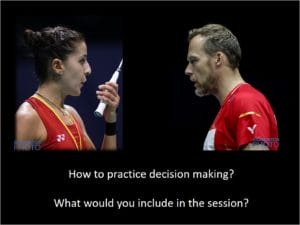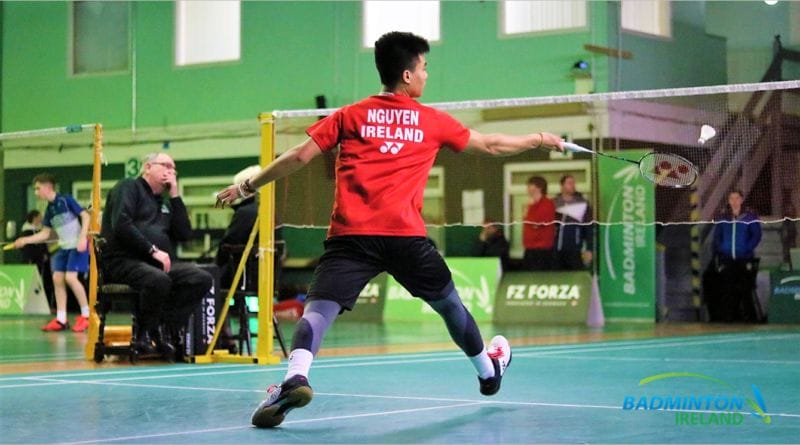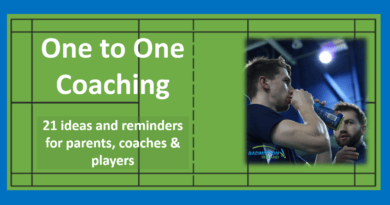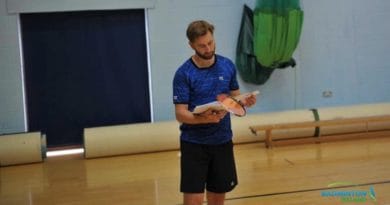6 Ways to improve your badminton movement
What are the components of great court movements?
Hopefully already know most of them, but here are 6 to consider
Having great court movement will save you energy, get you to shots faster & you’ll see the game differently
You will be able to decide what to do rather than just react and get the shuttle back over.
Do you want to explore different types of movements, understand the value of stances and anticipatory skills.
Then start to question what you’ve read about the ‘split step’
– – – – – – – – – – – – – – – – – –
1 Consider all movement types
2 Remember that recovery is important
3 Early to the shuttle as it is one of the Playing Basics
4 Stances, do you use them?
5 Pretension / Split Step
6 Anticipatory Skills, can you develop them?
They key to movement practice is to move as you would in a match.
How many times do you practice recovering to the shot you’ve just hit?
It’s often these recovery movements that act as early preparation for the next
Your Challenge:
When you have read the 6 points, think about which ones you agree with and which ones you currently allow for in your practices
– – – – – – – – – – – – – – – –
1 – Consider all movement types
Having good movement skills will make you faster on court.
Good movement skills will also cause less stress on your body in the long-term and be more efficient, therefore saving energy in matches.
Ensure that you practice all different types of movements and are able to combine them together. It’s very unlikely that one type of movement will always apply in a given situation. No matter what you hear from coaches or players you will need to be able to combine all or some of these movements when playing the same strike.
Be flexible in your thinkings and look to include all these in your practices
- Chassing
- Running
- Lunging
- Stopping
- Starting
- Don’t forget to include stances, all 3 of them
Don’t just practice one style and presume that it will be applicable to all court movements.
For example : Some people believe that you should always chasse in the forecourt going to the net. Take a look at different World Class players and you will see both chasse and running steps. Running is faster than a chasse technique, especially over a longer distance. However, a chasse movement maintains a sideways approach which is important. It’s also great for shorter distances and is desirable when combined with a strong ‘foot out’ in approach.
If you are able to chasse everywhere in practice then maybe your practices are ‘allowing’ for this movement
Be careful that you don’t set up your practices to prove your theories
As you grow stronger and your body changes shape your movements will change. Be prepared to adapt and use these changes to help yourself.
It may mean a change in your thinking or questioning your coach.
The key is to be aware that as you change physically and mentally, plus technically and tactically so you need to adapt your movement. Therefore not all the things you did 3 years ago need to apply right now. I’m recommending that you have an open mind before reading the rest of this post.
If you believe that there are fix ways to move with no regard to who is in front of you, then the thoughts below may cause you some upset
Be parepared to test your convictions and take into account a players : maturity, technical skill level, tactical desire, or physical condition
– – – – – – – – – – – – – – – –
2 – Recovery is important
The recovery part of badminton movements is often forgotten in practice.
However, it plays a vital part when changing from one movement to another. An efficient, well-timed recovery will speed up how quickly a player can use their early preparation for the opponents next shot. In practice, allow for recovery as part of the stroke practice so it’s an early preparation for the next.
For example, net shot lunges do not just finish when the shuttle goes over the net
Recovery is by moving slightly backwards & pre-loading your legs in preparation for the next movement
This is really only effective if the same shuttle is returned, assuming that it actually went over
What did you imagine?
In the above example did you imagine a multi-shuttle practice or two people (Player & Player, or, Player & Coach) in a mini-rally? The reason I ask is that the aspect of effective recovery is often overlooked in multi-shuttle practices. Recovery is not just a movement but a timed/anticipatory movement based on what has just happened and what is likely to happen.
I would like you to question if the ‘recovery’ you see in multi-shuttle is actually a game-like recovery and does it establish the skill of recovery that leads to rally winning ‘game’ players?
Or is the recovery actually ‘controlled’ by the feeder, who decides how much or how little time is given to the player.
Practice recovery for all strokes: good or not so good
It is important to practice recovering from all your strokes ‘good or poor’, why should it matter, they both happen in a match. Again this is difficult if the same shuttle is not returned by the feeder/coach/opponent.
Understanding what to do when your shot is not ‘perfect’ (and how little is it ever perfect) is very important.
The recovery after playing a Round the Head Straight Slow Drop depends on the outcome and what your opponent may or may not do. Remember you start your recover well before the opponent strikes the shuttle.
Are you will be able to feel and anticipate what may happen next as soon as you strike the shuttle, it’s important that you anticipate, prepare early for the most likely stroke
How would you recover in these situations?
After reading each one stop and consider your recovery
- your opponent was expecting a smash and you feel that you have caught them with your great slow ‘stop’ drop and they seem to be struggling to move forward
- you drop is pushed too hard and it’s likely that it will go past the service line and your opponent seems to be waiting for it and is starting to move forwards
- you hit your drop into the net and its the end of the rally
1. Start to move directly/straight forward anticipating a return close to the net
I presume that you see yourself almost running forwards. Remember they may hit a straight or crosscourt net, but hopefully, they will not be tight or if they are your quick flick will stress them as they struggle to recover from the low lunge.
I hope that you’ve been thinking “I might be able to kill at the net IF I’m quick enough”
You will not chasse back towards the middle of the court/ split forwards then chasse into your backhand net! This will take too long your advantage may be lost.
2. Ah your shot isn’t what you expected! But you know that!
You move towards the middle’ish of the court BUT crucially you try to anticipate what they are likely to do. Have they been crossing these shots or have they been playing tight ‘fast’ nets?
As you move towards the middle’ ish they play a straight net and you immediately change direction and possibly chasse and lunge with foot ‘OUT’ low as you don’t want that shuttle to hit the floor. If they crosscourt, be prepared to Run and Jump Lunge, again thinking that the shuttle will not hit the court.
Even though your shot wasn’t as good as you wanted you are still prepared to play as crucially you have practiced many times what movements to do when the shot isn’t perfect. In fact, you don’t even realise this as why should you – it’s all automatic based on what you anticipated!
3. You hit into the net
However, its a multi shuttle practice so you don’t worry. You know that the coach will feed the 2nd shuttle over the net with just enough time for you to reach to take it high at the net as the coaching manual suggests.
Even as you get tired they feed so that you can strike it at the top of the net! (is this really what would happen in a match)
What recovery did you use? I presume that you either knew where the coach fed shuttle would go so you recovered straight to that. Or, they could feed anywhere so it didnt matter what recovery you used, it would be a guess!
Do you agree with all 3 of the statements above?
Recovery debate: what do you think?
A movement often discussed between badminton enthusiasts is the recovery from a ‘Forehand Round-the-Head (RTH)’
Should it be a chasse or a run style step?
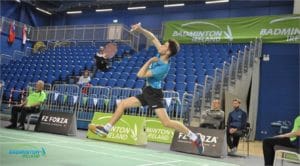 Of course, there must be a recovery, but which one do you use, which one do you coach, and do you ever change?
Of course, there must be a recovery, but which one do you use, which one do you coach, and do you ever change?
A .. Will the recovery be run or chasse style footwork?
B .. After playing the RTH stroke what will be your early preparation?
C .. How do you ensure that your practices allow for the answers you gave above?…. the clue hopefully, is in something earlier in this post.
For more on this recovery take a look at this post or click the image above – 6 ways to improve your round the head
– – – – – – – – – – – – – – – –
3 – Early to the shuttle
As a basic, players should, if tactically applicable, try to take the shuttle as early as possible
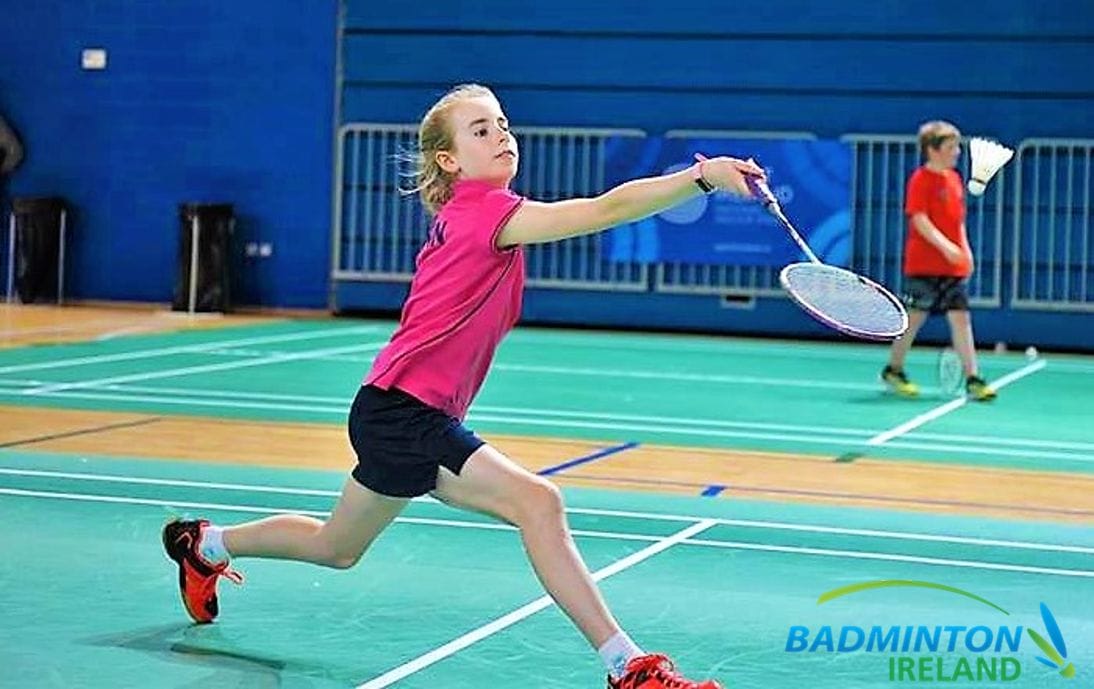
It’s important to instil this concept in developing players. The movements and techniques are important, but it’s more about a mindset.
Using this mindset will help you in a number of ways you will …
.. strike the shuttle early, reducing the time for your opponent to react and move
.. start to prepare your racket and body earlier – early preparation has many advantages
.. find that you have more opportunities for deception
.. find that you can play a different stroke or a variation of the one you intended
.. start to move faster (if you can cope with the increased physical demands!)
 Doing this often results in one or both feet off the court. Vertical and sideways jumping are important but master other movement skills first. Be aware that young players do not have the physical strength to make the teaching of vertical jumping an efficient use of time.
Doing this often results in one or both feet off the court. Vertical and sideways jumping are important but master other movement skills first. Be aware that young players do not have the physical strength to make the teaching of vertical jumping an efficient use of time.
However, do encourage them to ‘get off the ground’ when striking overhead strokes and especially ‘round the heads’.
Jump lunging and long stepping will also help players to take the shuttle early, especially below shoulder height. Have you read this post 6 Ways to coach racket preparation at the net
– – – – – – – – – – – – – – – –
4 – Stances
How familiar are you with 3 stances often seen in badminton singles?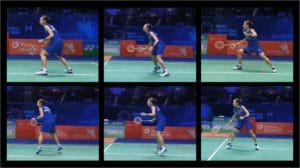
These stances are
- the forward attacking
- the square defensive
- the backward attacking
All these stances are ‘anticipatory’, i.e. they are adopted before the shuttle is struck by the opponent. Either as a timed transition between movements or as ‘early preparation’ at the end of the previous stroke/movement.
Please do not always hit and move to the middle of the court!
Read more by clicking this link : 6 Ways to understand everything about stances
The appropriate starting stance is vital for quick efficient movement. Stances will vary depending on the position of the shuttle and the likely replies from the opponent.
Adopt this in your singles game and improve your readiness
“When the shuttle is above the net and can be struck downwards by the opponent, stand square on in a defensive stance”
“When the shuttle is below the tape and cannot be struck downwards, use either the forward attacking or the backward attacking stance”
If you are wondering what shot or shuttle to cover first and find it hard to anticipate, then a general rule I like is
“prepare to move to the shuttle that will hit your court first !”
– – – – – – – – – – – – – – – –
5 – Pretension / Split Step

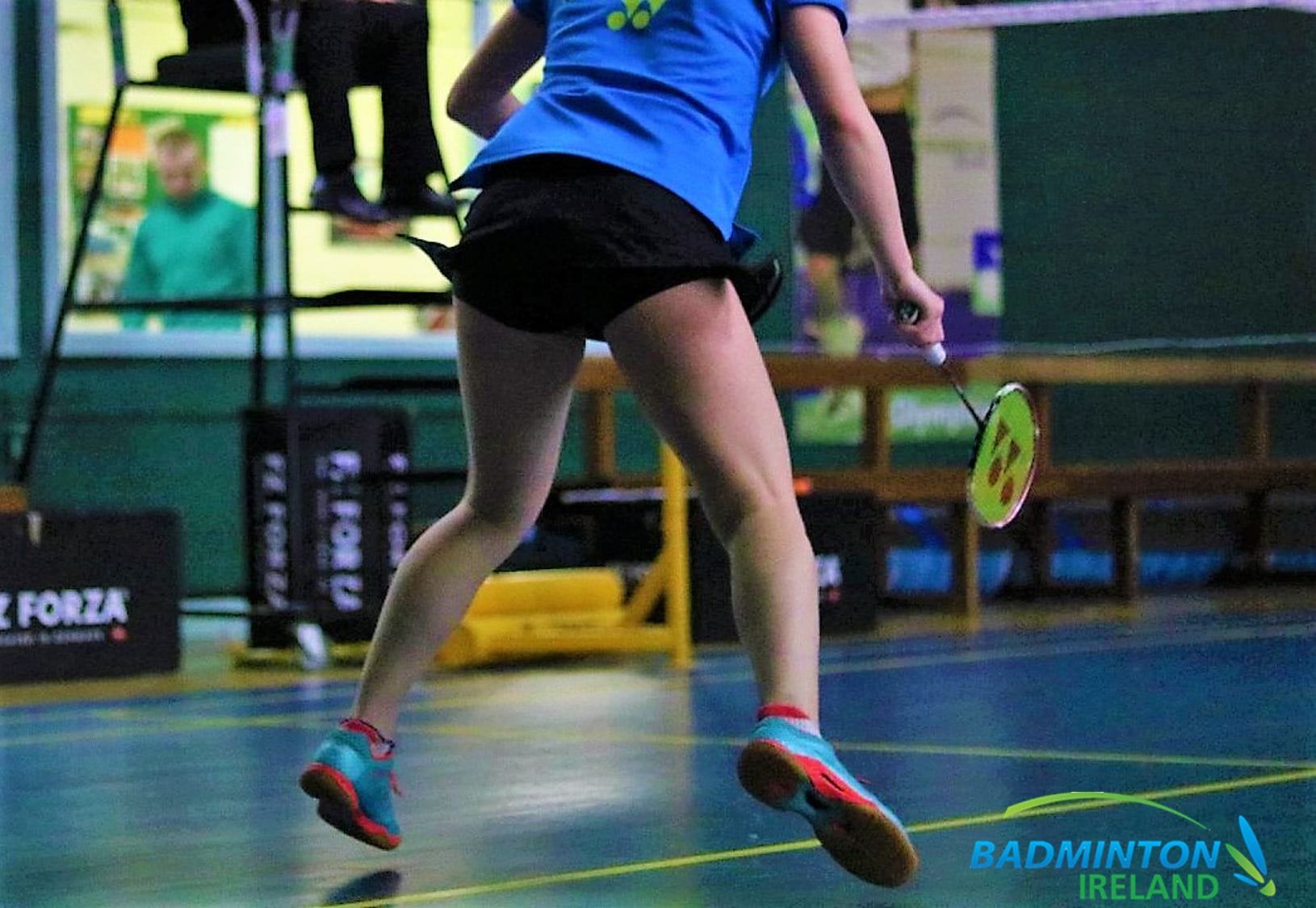
These terms describe the same starting badminton movement. Nearly all movements will start with a timed loading of the legs.
The loading movement is often combined with adopting a stance (see no. 4 above) or in the transition between other movements such as recovery and early preparation.
Pretension, correctly timed, can increase the speed of the initial movement and will also allow the player to change direction quickly. This movement is ‘anticipatory’, meaning that it is started before the opponent strikes the shuttle.
Take a moment and think about what you have been told or instructed on coach education courses or by your coach.
Are you encouraged to take up the split-step stance before or after the opponent strikes the shuttle?

There are 2 situations to look out for:
- an ‘early preparation’ stance at the end of the last stroke/movement, e.g. after serving or after blocking a smash. Often easy to see when watching a match as there maybe be a slight pause just before the movement.
or
- a timed transition between movements. This may not be as apparent as the previous one. The pre-loading is often derived from a ‘landing’ or ‘changing direction’ within the rally.
If you feel that you don’t currently do either of these movements then ask a friend or coach to watch you and check. Ideally, you will be doing them without knowing it, it’s called expert amnesia. If they don’t see this timed pre-loading then its time to start practicing! Remember loading your legs (the start of the movement) happens before the shuttle is struck, not afterwards. It’s too late then!
Questions for you and your coach
1 How to incorporate the Pretension/Split Step movement into a practice that use real game-like situations?
2 What suggestions or instructions could be used?
3 How do you ensure that the movement is anticipatory and not after the shuttle is struck
4 Do you practice not knowing where the shuttle (feed) is going?
5 How do you start the development of this split/pretension, using what practices?
it’s not about doing it when someone shouts “split”
-
It’s your choice when to move
-
Your movement to initiate
-
Your timing
-
be prepared to experiment/fail and then after a while forget you ever learnt it
– – – – – – – – – – – – – – – –
6 – Anticipatory Skills
Good anticipatory skills are essential for quick badminton movements.
If you feel confident in your anticipation you will find that you have ‘extra’ time to prepare. The development of anticipatory skills is often overlooked in favour of technical or physical development. So how are you ensuring that your practice develops your anticipatory skills?
I hope you agree that you can develop and improve someones ability to anticipate.
It can be tested in situations where you don’t know where the shuttle is going, but you have enough information and confidence in your ability (your anticipation) to make an early movement or decisive thought.
If you agree that it’s important and that it can be developed then consider:
what types of practices and what percentage of time a week is aimed at developing anticipation and preparation skills?
The key to increasing faster reactive movements in a match is to practice with indecision in training.
Check to see how much of your weekly training includes real game-like decisions. Those types of decisions that you make in a competitive match.
Do your practices include:
- the shuttle being returned by an ‘opponent’ and then you move to that same shuttle
- game speed movements
- the ‘feeder’ / practice partner holding a racket and moving in preparation to everything that you hit
- opportunities for you to ‘see something over the net’ that allows you to make a decision, to anticipate the opponents’ reply and prepare for that
- opportunities for you to use the timed stances (see No. 4 above)
- include winners and losers so you can learn and adapt. Does your partner/feeder sometimes try to beat you or give you easy kill opportunities
